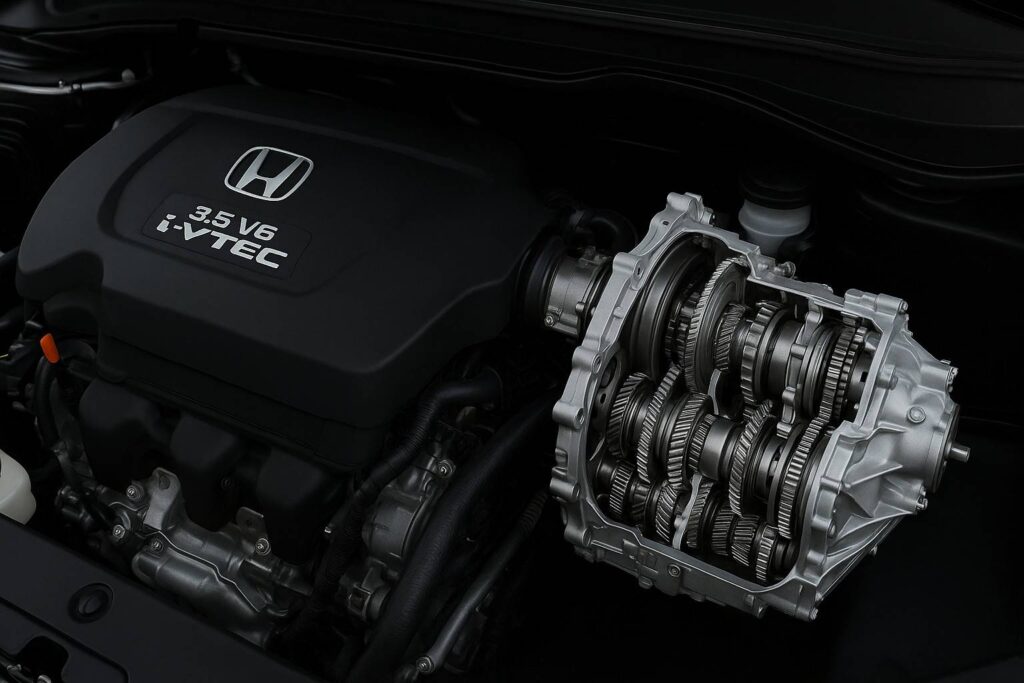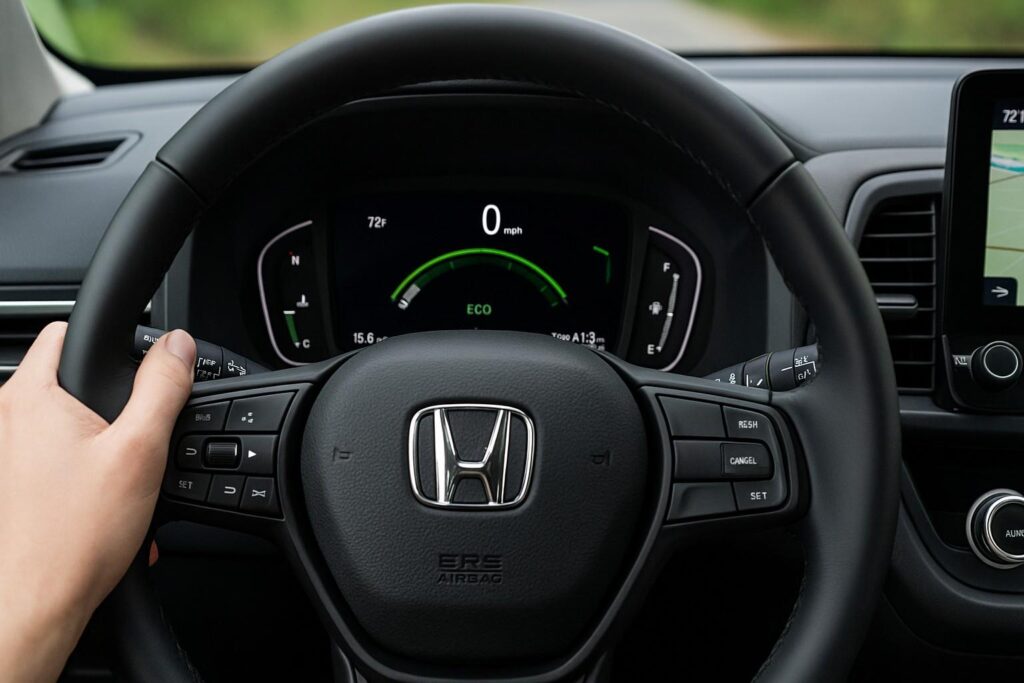Impressive 2025 Honda Pilot Gas Mileage Explained

The 2025 Honda Pilot gas mileage shows how far family SUVs have come in balancing strength with sensibility. Designed for long road trips, school runs, and everything in between, the new Pilot delivers more miles per gallon without compromising the power drivers love from its V6 engine.
Honda achieved this through a series of quiet improvements — lighter components, smarter transmission tuning, and aerodynamic refinements that make real differences at the pump. The result is an SUV that feels confident, comfortable, and surprisingly efficient for its size. Let’s explore how it all comes together on the road.
Quick Overview Table
| Spec | 2025 Honda Pilot Data |
| Engine & Transmission | 3.5-L V6 i-VTEC (285 hp) + 10-speed auto |
| Power / Torque | 285 hp / 262 lb-ft (213 kW / 355 Nm) |
| Fuel Efficiency (MPG / L per 100 km) | 19 city / 27 highway / 22 combined ≈ 8.7 – 10.2 L/100 km |
| Price Range (Est.) | $38 000 – $53 000 USD |
| Trim Options | Sport, EX-L, TrailSport, Touring, Elite |
| Highlights | Eco Assist System, Idle Stop, Improved aerodynamics |
A Closer Look at Fuel Economy
Honda’s 2025 Pilot doesn’t rely on gimmicks. It still uses a V6, but a smarter one. Engineers cut friction inside the pistons, adjusted valve timing, and re-mapped the 10-speed transmission so the SUV keeps low RPMs even when loaded.
The result? A one-to-two-MPG bump over last year’s model. It’s not headline-grabbing, but in everyday use that’s the difference between refueling every five days or every six—a small gain that adds up across years of ownership.
Mileage by Trim Level
| Trim | Drivetrain | City / Highway / Combined |
|---|---|---|
| Sport | FWD | 19 / 27 / 22 MPG |
| EX-L | FWD | 20 / 27 / 23 MPG |
| TrailSport | AWD | 18 / 24 / 21 MPG |
| Touring | FWD | 20 / 27 / 23 MPG |
| Elite | AWD | 19 / 25 / 22 MPG |
Front-wheel-drive trims naturally return the best numbers, while the TrailSport—built for dirt and gravel—trades a bit of efficiency for traction. Even then, 21 MPG combined for an off-road-tuned SUV is solid.
What Makes It More Efficient

A Smarter V6
Honda’s long-running 3.5-liter V6 now benefits from direct injection 2.0 and cylinder-deactivation logic. Under light throttle, it quietly runs on fewer cylinders—something you barely notice but your wallet will.
Transmission Tuning
Ten gears might sound like overkill, yet it works. Lower gears get you moving quickly; upper ones drop engine load on highways. Smooth and responsive, it’s part of why the Pilot feels lighter on fuel than it looks.
Eco Assist + Idle Stop
Those green-to-blue dash lights aren’t decoration. They coach you into gentler throttle use, while the Idle Stop system saves fuel every time traffic comes to a standstill. Honda estimates a small but real improvement in urban efficiency.

EPA Ratings vs Real Life
Laboratory figures say 22 MPG combined, but real owners often report 21–24 MPG depending on conditions. Long highway runs with cruise control can reach 28 MPG, and that’s without any hybrid help.
It’s worth noting that the Pilot’s real-world mileage remains consistent—something turbo-charged four-cylinder rivals can’t always claim once fully loaded.
Dive into 2025 Honda Pilot Towing Capacity to see how power meets practicality, and how Honda balances performance with efficiency across all driving needs.
City vs Highway Driving
In the city, weight and stop-and-go traffic are your main obstacles. The Pilot handles them gracefully, thanks to linear braking and quick restarts after Idle Stop. On open highways, aerodynamic tweaks—a re-angled grille and smoother mirror design—reduce drag enough to keep highway MPG near 27.
Drivers switching from older V6 SUVs often notice how quietly and smoothly the new Pilot maintains 70 mph without strain.
Factors That Shape Your Mileage
- Proper tire pressure (32–35 psi) keeps rolling resistance low.
- Excess cargo adds drag and weight—pack light when possible.
- Driving habits matter; steady throttle saves ≈ 2 MPG.
- Keep to scheduled oil changes and use 0W-20 synthetic.
- Turn off AWD Lock on dry pavement to avoid extra friction.
Follow these and your Pilot should hold EPA numbers well past the 100 000-mile mark.
How It Compares
| Model | Engine | Combined MPG | Comment |
| Honda Pilot 2025 | 3.5 L V6 | 22 | Smooth and consistent |
| Toyota Highlander 2025 | 2.4 L Turbo | 24 | Better in city, less refined sound |
| Kia Telluride 2025 | 3.8 L V6 | 21 | Strong power, lower efficiency |
| Chevy Traverse 2025 | 3.6 L V6 | 20 | Heavy and thirsty |
The Pilot doesn’t top every chart, but it scores for predictable real-world performance and lower long-term running costs.
(Official EPA ratings via FuelEconomy.gov) 🔗
The Hybrid Question
Honda hasn’t rolled out a Pilot Hybrid yet, but the groundwork is there. The brand’s hybrid-electric systems from the Accord and CR-V are expected to reach the Pilot line soon, likely lifting combined MPG past 30. Until then, the current model’s software already imitates hybrid efficiency—minus the extra weight or complexity.
Simple Habits to Save Fuel
- Check tires and alignment every month.
- Replace air filters every 15 000 miles.
- Remove roof boxes or racks when not needed.
- Drive in Eco Mode during city commutes.
- Plan errands to combine short trips into one.
These low-effort habits can raise efficiency by 5–7 %—no gadgets required.
Expert and Owner Impressions
Reviewers call the 2025 Pilot “a textbook example of gradual improvement.” It may not chase hybrid bragging rights, but it delivers what families actually need: stability, comfort, and predictable fuel use.
Long-term owners echo that sentiment. They report smooth highway behavior and appreciate how the Eco Assist system encourages calmer driving. Maintenance costs also stay modest—thanks to a proven V6 and transmission combo Honda has refined for years.
Environmental Impact
With roughly 405 g CO₂ per mile (252 g/km), the Pilot sits mid-pack for large SUVs. Honda offsets part of that footprint by producing the vehicle in energy-efficient facilities and recycling manufacturing waste.
For drivers conscious about emissions but not ready for full electric, this SUV offers a sensible middle ground—capable, roomy, and still respectful of fuel.

Conclusion
The 2025 Honda Pilot Gas Mileage story is simple—it’s about refinement paying off. Honda didn’t chase trends; it focused on making every system a little smarter and every drive a little easier on fuel.
For families who want reliability, comfort, and an honest 22 MPG combined without going hybrid, the Pilot remains one of the most well-rounded choices of 2025.
Discover expert car tips, towing guides, and vehicle insights at CarFact.online.
Frequently Asked Questions
Q 1: How many MPG does the 2025 Honda Pilot get?
Expect 19 MPG city, 27 highway, 22 combined depending on trim and driving conditions.
Q 2: Is it fuel-efficient for its size?
Yes. Among three-row V6 SUVs, the Pilot ranks near the top for balanced performance and efficiency.
Q 3: Will there be a hybrid version?
Honda plans a Pilot Hybrid in the near future, but the 2025 gas model already uses eco-minded software to save fuel.
Q 4: Which trim gets the best mileage?
The EX-L and Touring FWD versions lead at 23 MPG combined.
Q 5: What type of fuel should I use?
Regular 87-octane gasoline is recommended. Premium does not improve mileage.
Have questions about the 2025 Honda Pilot Gas Mileage? Contact us—we’re here to help you find the right answers.
